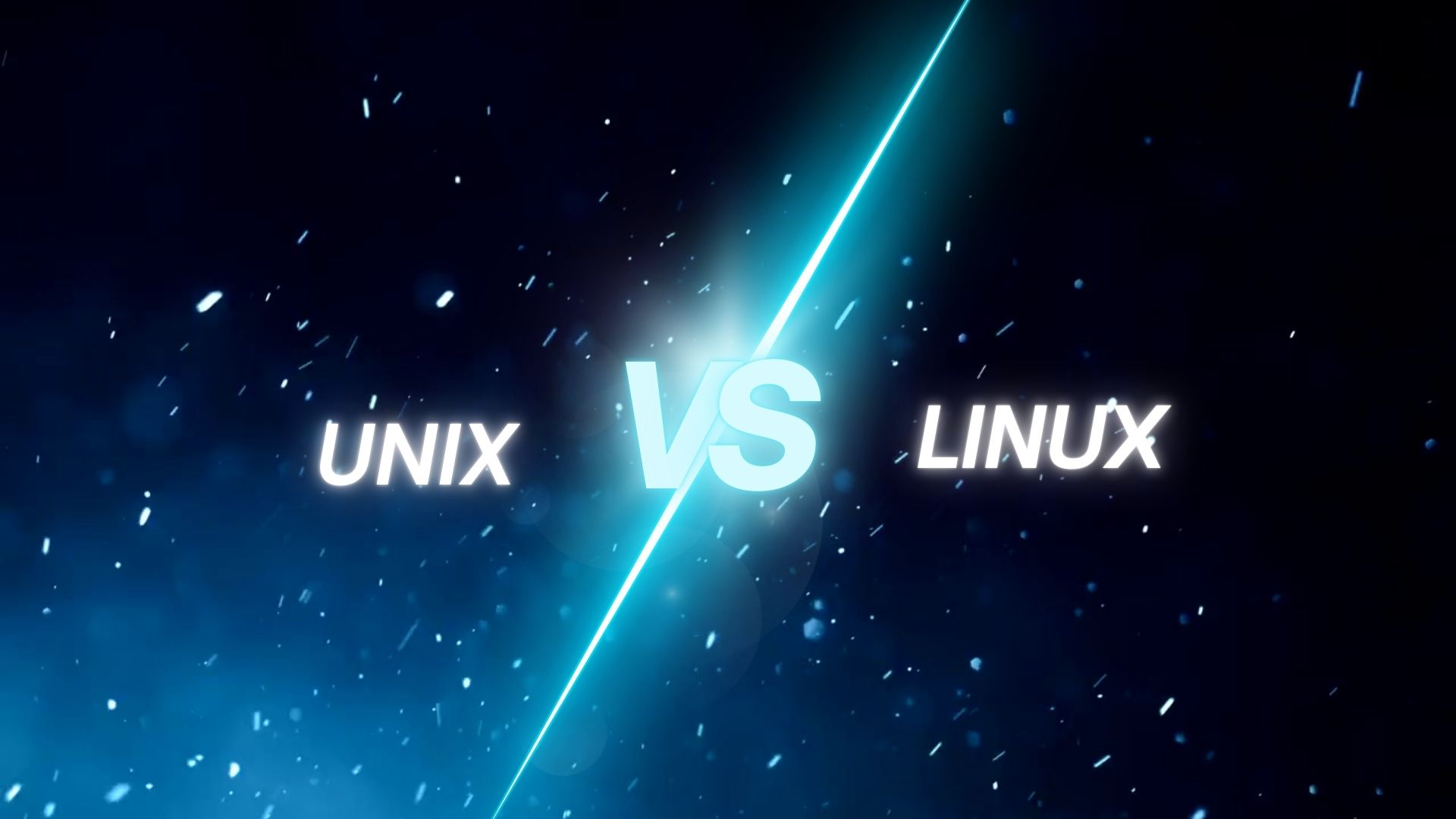Two titans of the tech industry, Unix vs Linux, have dominated how our gadgets work for a long time.
Knowledge of Linux and Unix operating system characteristics can help you make an informed decision that best matches your infrastructure, whether you’re managing enterprise-level apps or heavily trafficked websites.
The most common question asked by many IT developers or professionals “Is Linux and Unix the same”. These operating systems differ noticeably from one another even though they have some similar roots.
This article answers all your questions, We’ll look at what distinguishes Unix vs Linux, as well as how each operates, affects performance, server security, scalability, and which operating system will be the right choice for your server environment.
Unix vs Linux: A Quick Overview
What is Unix? Background & Features
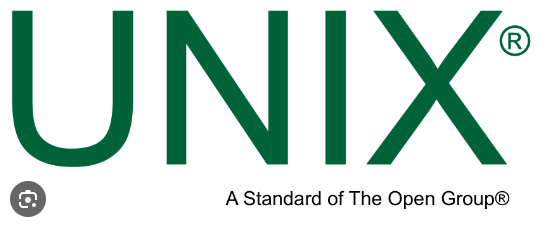
With its foundational work on numerous Operating Systems, consider Unix to be the sage of the group. Unix, often known as UNIX, is an operating system (OS) that supports multiple users and multitasking, with an emphasis on adaptation and flexibility. Unix was one of the first operating systems created in the C programming language, having been developed in the 1970s.
The computer and electronics industries have been greatly impacted by the Unix operating system and its derivatives ever since they were introduced. providing stability, portability, and compatibility in a variety of diverse settings and gadget kinds.
Get exclusive access to all things tech-savvy, and be the first to receive
the latest updates directly in your inbox.
The kernel, a key control program that offers services for initiating and terminating processes, is the brain of the Unix operating system. It also performs low-level functions, such as memory allocation, file management, answering system calls, and scheduling jobs.
What is Linux? Background & Features

The Linux operating system powers the majority of devices, except laptops and PCs. An open-source operating system based on Unix, created in 1991, Linux is essentially the name of the kernel.
The Linux kernel is developed collaboratively by the community under the direction of Linus Torvalds. To complete its operating system, Linux has apps and a graphical user interface similar to Windows in addition to its command line interface.
It provides a range of distributions, each suited to a distinct user base, such as Fedora, Debian, and Ubuntu.
Linux is a highly customizable and flexible operating system that is well-liked by developers and has ongoing community support and updates.
Is Linux and Unix the Same?
A very common question I talked about earlier, asked by seasoned IT developers. So the answer is NO!!
The two operating systems Unix vs Linux share many common features or let’s say ancestry, BUT THAT DOESN’T MAKE THEM IDENTICAL. Despite having separate developmental paths at first, they were both inspired by the same idea—a multi-user operating system. Linux and Unix operating system was based on each other, but what makes them different are their approaches to licensing, development, and availability.
Linux vs Unix Operating Systems: Core Similarities
- Can Operate Multiple Users and Processes Simultaneously: Unix vs Linux are both multiuser and multitasking platforms by design.
- Command-Line Interface (CLI): They come with a comprehensive command-line interface that is required for developers and system administrators to effectively manage files and processes.
- File System Hierarchy: The file systems of Linux and Unix are structured similarly, with the root directory at the top and subdirectories below.
- Programming Language Support: The systems are very adaptable for software development since they provide robust support for programming languages such as C, C++, Python, and Shell scripting.
- Network Support: Strong networking capabilities are a hallmark of Unix vs Linux, and essential for server operations and large-scale network management.
Linux vs Unix: What Sets Them Apart?
Here is a table showing the difference between Unix and Linux, let’s explore further.
| Feature Difference | Unix | Linux |
| History | The AT&T Bell Labs launched and distributed this operating system in 1960. | Linus Torvalds introduced this operating system on 17th September 1991 at the University of Helsinki. |
| License | As a proprietary operating system, Unix needs a license in order to be used. | open-source free software does not require a license to use. |
| Kernel Type | They are less complex than the Unixhold-up that kernel, but they both have a similar concept. (Monolithic kernel) | They are less complex than the Unixhold-up kernel, but they both have a similar concept. (Monolithic kernel) |
| Hardware Compatibility | limits to specific hardware (mostly proprietary and RISC systems). | Not limited, compatible with a range of hardware, from PCs to servers. |
| User Base | Mostly used by corporations, academic organizations, and specialist systems. | extensively used by businesses, web hosting cloud servers, and developers. |
| File System Support | supports a variety of file systems-JFS, gpfs, hfs, hfs+, ufs, xfs, and zfs | Highly versatile, Ext3, Ext4, JFS, ReiserFS, XFS, BtrFS, FAT, FAT32, and NTFS are among the file systems supported. |
| Graphical User Interface | Initially a command-based operating system later developed into the Common Desktop Environment, a GUI that is now used by most distributions under the Gnome name. | provides two GUIs, KDE and Gnome. But there are many other options. For example, LXDE, Xfce, Unity, Mate, and so on. |
| Language | C and assembly language. | C and other programming languages. |
| Support & Updates | upgrades that are slower and usually vendor-specific. | Quick updates, supported by a sizable community of open-source users. |
| Source Code Availability | The source is not accessible to the general public. | The source is accessible to the general public. |
| Cost | Expensive, licensing fee required. | Free, open-source & paid enterprise versions |
| Security | Considered secure but can be expensive to maintain. | robust security features that are updated frequently by an large active community. |
| Latest Versions | AIX 7.3, HP-UX 11i v3, Solaris 11.4 | Linux Kernel 6.5.3, Ubuntu 23.04, Debian 12, RHEL 9.3 |
Difference Between Unix and Linux: Key Features in Detail
The table shows an overview of where the Linux and Unix operating systems are different. Here are a few features discussed in detail and see how they control the technology we use daily!
1. Unix vs Linux: How User Interface Variations Differ
Although the command-line interface brings Unix vs Linux together in textual simplicity, there are still issues with different user interfaces.

In Unix
A Command-Line Interface (CLI) is a feature of most Unix systems that emphasizes using the terminal to manage the system and execute commands. With their scripting language, Unix systems may use a variety of shells, such as the Bourne Shell (sh) as default, the Korn Shell (ksh), or the C Shell (csh).
Although it can be easily adapted to new use cases, sh or ksh is the foundation of classic Unix shell scripting. Some variations of Unix support Bash, but it’s less common yet.
In Linux
On the other hand, a wider variety of desktop environments and Graphical User Interfaces (GUIs) are available with Linux distributions, offering a more uniform experience across distributions since it frequently uses the Bash shell (Bourne Again SHell) as the default.
Some of the most well-liked choices are Lightweight X11 Desktop Environment (LXDE), XForms Common Environment (Xfce), K Desktop Environment (KDE), and GNU Network Object Model Environment (GNOME).
Linux shell scripting is more robust and flexible, providing modern features, especially when used with Bash.
The symbols, menus, and windows these interfaces offer make it easier for users to navigate and interact with the system and make it visually appealing.
2. Unix vs Linux: How the Kernel Architecture Differs
Unix vs Linux both operating systems have a similar architectural foundation. Both operating systems support multiple users and multitasking, enabling simultaneous system access from many users.
Unix Architecture
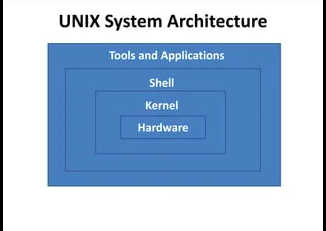
The Unix uses a Monolithic Kernel, the program that controls everything. In general, the term “Unix” refers to a group of exclusive (proprietary) operating systems normally used in internet servers, workstations, and PCs by Solaris, Intel, HP, etc (AIX, HP-UX, Solaris). So kernel space is where the main operating system (OS), device drivers, file systems, and networking functions are.
Commands, application programs, and the shell are located in the outer layers of the architecture. Shell is the interface between the user and the kernel. Shell and the user input commands, decipher them and then invoke the corresponding computer programs.
Unix Kernel is usually hardware specific, e.g SPARC, POWER), After it has been constructed and put into operation, the Unix kernel is more static and does not allow for the dynamic addition or removal of modules.
Linux Architecture
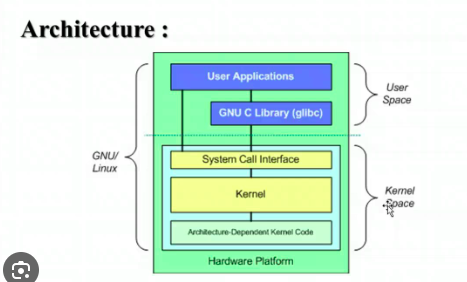
Linux also uses a fully open-source monolithic kernel, with its high level of modularity, modules (such as device drivers) can be automatically loaded and unloaded without requiring a reboot. It also supports Loadable Kernel Modules (LKMs), providing more flexibility.
The Linux kernel is an important distinction since it gives consumers the freedom to select the kernel that best fits their requirements, whether for CentOS, Ubuntu VPS servers, or another distribution and developers to view, modify, and distribute the code freely for an overall faster development process.
Linux distributions, or distros, come with multiple kernels. The image below shows a further detailed representation of its architecture:
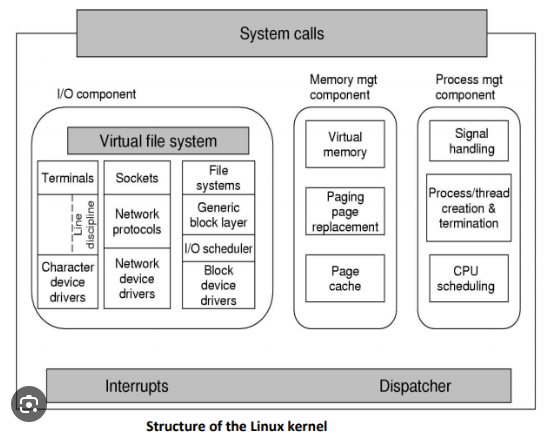
Here are some of the important kernel types which are mentioned below:
- Monolithic Kernel
- Microkernels
- Exo kernels
- Hybrid kernels
Then Linux also works well with different hardware architectures, including PCs and supercomputers, and is incredibly portable. It supports x86, ARM, and PowerPC.
3. Unix vs Linux: Security Features Compared

let’s find out the difference between Unix and Linux security features.
Unix
In Unix, security is backed by discretionary access control (DAC), The file owner chooses who can read, write, or execute files by permission settings (e.g., read, write, and execute permissions).
Because SELinux-enabled versions enforce system-wide regulations regardless of user permissions, certain Unix variants (like Solaris) employ MAC for tighter control and careful file permission settings strengthen Unix’s security further. Unix’s resilience depends on regular security updates and patches, which fix bugs and strengthen the system’s defenses against malware attacks.
The lack of the source makes infection much more difficult. These days, there are no viruses for Unix that are actively spreading.
Linux
Also using DAC, Linux protects digital assets with a wide range of security features that it has developed by taking up and improving upon the security concepts of Unix. To provide a strong defense against potential threats to valuable digital assets, the discretionary access control (DAC) model is enhanced with capabilities and access control lists (ACLs) for permission control.
Another very useful feature it implements to ensure security is PAM (Pluggable Authentication Modules) which offers a flexible multi-factor user authentication, This makes centralized management of authentication policies and multi-factor authentication possible. Linux also supports AppArmour, to control application behavior.
4. Unix vs Linux: Software & Application Compatibility
Unix
The software environment on Unix vs Linux operating systems, well-known for their dependability and stability, is complex. Because many Unix versions are proprietary, software is created and distributed by individual vendors in a more regulated environment.
In contrast to Linux, this method can restrict the availability of a wide variety of applications, even though it guarantees system reliability.
Linux
In contrast, Linux has become a part of a thriving software industry due to its open-source ideology. This makes Linux a desirable platform for developers as well as end users, as it provides a multitude of applications and necessary system utilities.
Cross-compatibility issues between Unix vs Linux operating system continue despite their shared history, due in part to the private nature of some Unix systems and the architectural differences between Unix and Linux.
5. Unix vs Linux: Commands
Numerous strong command-line tools are available for networking, file management, programming, system administration, and other tasks in both operating systems. In Linux and Unix operating system, standard commands like ls, cd, mkdir, rm, and grep function in the same way.
As a result, although there are some variations, the terminal commands in Unix vs Linux operating systems are not exactly the same.
I have also shown common command examples used in both Unix vs Linux, but show differences in their output and options.
Unix Commands
Because Unix systems are older and more dispersed, their commands are frequently unique to the Unix version that is being used (such Solaris, AIX, or HP-UX).
Many Unix commands follow POSIX standards, but still, some Unix variants have unique or let’s say exclusive commands, While they might not have as many features or flexibility as commands, commands are usually more reliable. Restricted compatibility between platforms, Depending on the Unix version being used, commands may vary.
Example: Depending on the version, the ls command in a Unix system may have fewer options than others when it comes to listing directory contents.
ls -l
Linux Commands
Linux commands are more modern versatile and standardized as its open-source. Most Linux distributions use GNU core utilities to provide a uniform and standardized command set for many Linux distributions that result in greater functionality and a wider range of options.
Because of the commands’ consistency and versatility, they are very well suited for automation and scripting with human readable sizes and color coding. Compared to Unix commands, Linux commands are more user-friendly since they are frequently updated with new functionality.
Example: The command in a Linux system has more features and options.
ls -lh --colorThe –l option lists files in a Unix-like long format.
Sizes are shown in a human-readable format (e.g., KB, MB) when using the -h option.
—color option: Allows color coding to make file type distinction easier.
That’s all for the difference between Unix and Linux, to choose the right operating system you must keep these in mind!
Conclusion: Unix vs Linux – Which OS is Right for You?
The way operating systems have developed has caused a big difference in the things that people like about Unix and Linux. This article has discussed each Unix vs Linux feature in detail for you, answered the critical question “Is Linux and Unix the same?”, and then also discussed their core similarities.
In conclusion, The main difference between Unix and Linux is the Kernel architecture, Wrapping it up
Unix is older so definitely has an edge there, a go-to option for business-level operations, particularly in settings needing a lot of processing power and stability.
On the other hand, initially regarded as a research project, Linux has gained widespread use in small and medium-sized firms, and large corporations for office applications and web hosting, accounting for a substantial share of the server market.
A suggestion for organizations to carefully evaluate their operating demands to determine which of Unix and Linux is the better option then see what works for you.
FAQ’s
1. What is the main difference between Unix and Linux?
Linux is an open-source, widely used operating system, whereas Unix is a proprietary version.
2. Is Linux and Unix the same?
No, they are not the same; Linux gives greater flexibility, but Unix is typically more stable.
3. Which is more secure, Linux or Unix?
Although both are safe, Linux has advanced to include contemporary security features like access control lists.
4. Is it possible to run software on Linux and Unix simultaneously?
While some programs can run on both, some might only function on one because of the differences in architectures.
5. Which operating system works best for businesses?
Depending on the requirements, Linux is more adaptable for a wider range of applications, while Unix excels at high-end processing.
